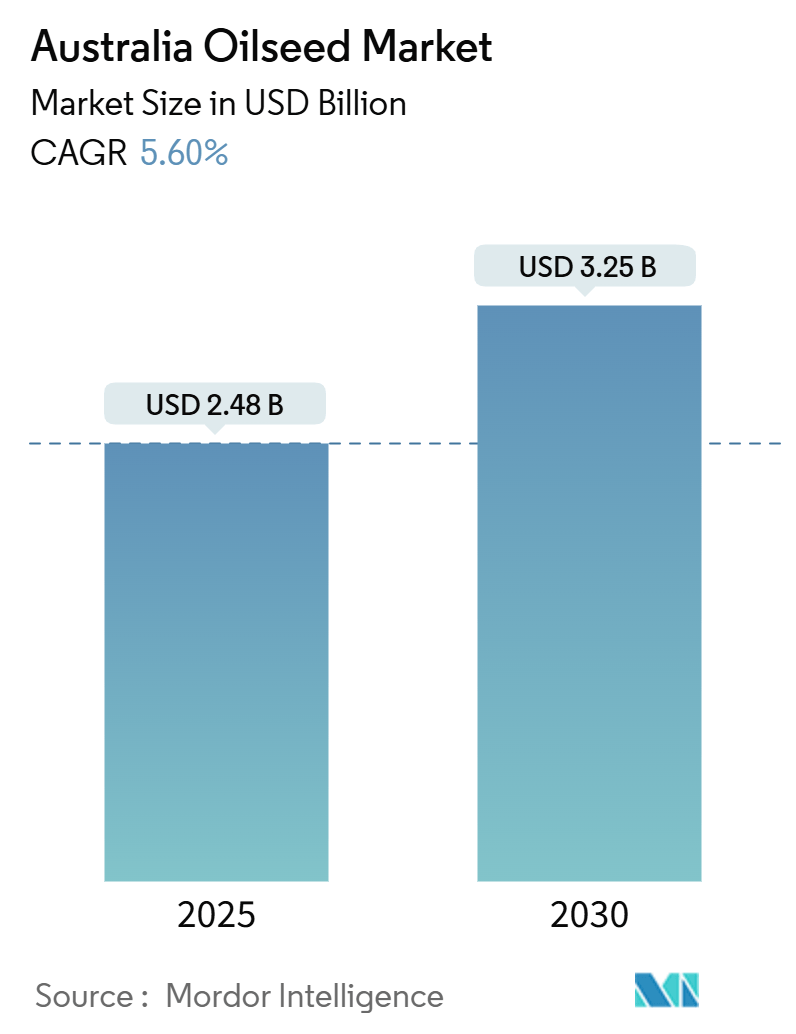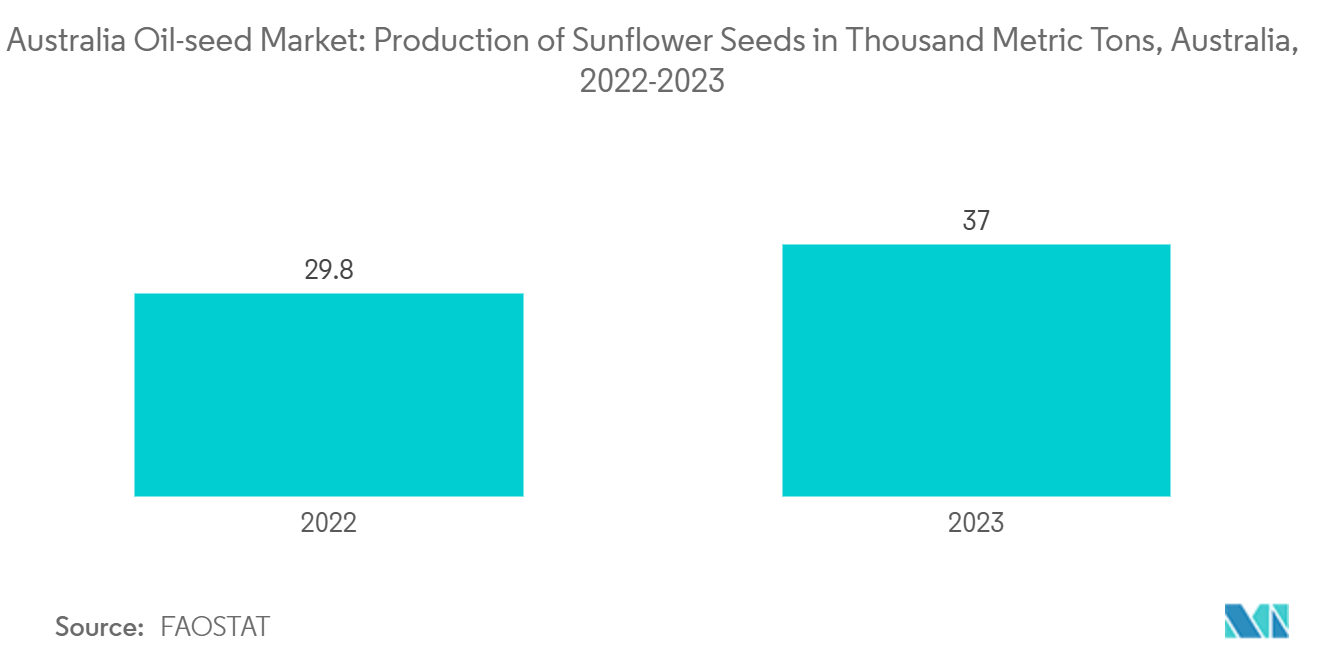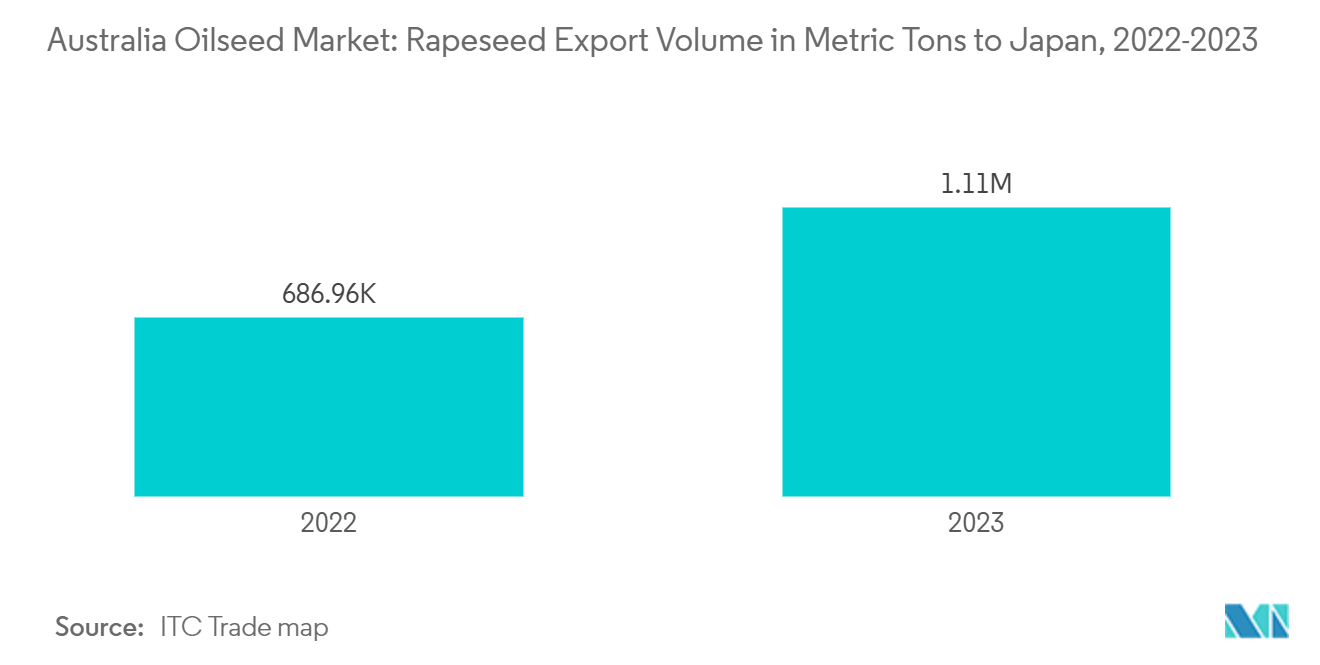
Australia Oilseed Market Analysis by Mordor Intelligence
The Australia Oilseed Market size is estimated at USD 2.48 billion in 2025, and is expected to reach USD 3.25 billion by 2030, at a CAGR of 5.60% during the forecast period (2025-2030).
The Australian oilseeds market plays a significant role in the country’s agricultural sector, with oilseeds being grown for various purposes, including food products, animal feed, and biofuels. Key oilseeds produced in Australia include canola, sunflower seeds, and soybeans, with canola being the most prominent oilseed crop.
The demand for canola oil has increased due to growing health awareness among consumers, leading to a rise in rapeseed demand for oil processing across countries. Favorable climate conditions in western and southern Australia, combined with improved domestic and international canola prices, have boosted rapeseed production to meet expanding demand in importing countries. According to FAOSTAT, sunflower seed production in 2023 reached 37,045 metric tons increase from 29,800 metric tons in 2022. This has resulted in increased sunflower seed exports from Australia. ITC Trade Map data shows that in 2023, rapeseed exports totaled 299 metric tons in 2023.
Government initiatives to develop trade relations with Asia have highlighted the importance of high-quality GM and non-GM oilseeds from Australia in the region. The Australian Export Grains Innovation Center (AEGIC), in collaboration with Grain Trade Australia, has been working to develop Australian canola exports for Chinese processing industries. In 2024, the Australian government approved five genetically modified crops for cultivation and imports, including four oilseeds: canola, cotton, Indian mustard, and safflower, as reported by the Department of Health and Aged Care.
Australia Oilseed Market Trends and Insights
Growing Demand for Plant Based Oils
Consumer preference for plant-based oils such as canola, soybean, and sunflower oil is increasing, driving market growth. These oils are in demand for both culinary use and industrial applications, including biodiesel production. As a result, Australia is increasing oilseed production by expanding the area under cultivation. According to FAOSTAT, sunflower seed production in 2023 reached 37.0 thousand metric tons increase from 29.8 thousand metric tons in 2022. This rise in production corresponds to an increase in the cultivation area from 25,115 hectares in 2022 to 19,400 hectares in 2023.
Demand for canola oil and canola meal is rising in Australia due to their multiple uses. Rapeseeds are crushed to extract oil in the country. According to the USDA, report on Oilseeds and Products Annual, domestic canola crush is projected to increase to 1.2 MMT in MY 2024/25, up from an estimated 1.1 MMT in MY 2023/24. This increase in canola crush consumption is driven by the demand for canola meal, particularly in the eastern states where most beef feedlots, dairy, swine, and poultry operations are located. Furthermore, an existing processor on Australia's east coast plans to construct a new crushing facility in Western Australia. This rise in consumption is consequently boosting oilseed production in the country.

Increasing Oilseed Exports
Australia maintains strong trade relationships with countries such as Japan, UAE, and other Asia-Pacific nations, enhancing its oilseed exports, particularly canola. These markets require high-quality oilseeds for oil extraction and animal feed. Australian growers export oilseeds under the International Sustainability and Carbon Certification (ISCC) through the Sustainable Grain Australia program, ensuring certified sustainable biofuel inputs. According to the ITC Trade Map, in 2023, rapeseed exports to Japan reached 1,109,930 metric tons increase from 686,959 metric tons in 2022.
The Australian government is also establishing various trade agreements with importing countries to enhance oilseed exports. In 2024, Australia and the UAE signed the Comprehensive Economic Partnership Agreement (CEPA), eliminating a 5% tariff on canola seeds. This agreement provides duty-free access to the UAE market, where Australia's largest export is expected to reach AUD 741 million (USD 482.3 million) annually. The agreement also aims to reduce duties to zero on other oilseed exports, potentially giving Australian exporters a competitive advantage. Consequently, the country's oilseed export market is expected to grow during the forecast period.

Recent Industry Developments
- November 2024: The Australian Government and the United Arab Emirates (UAE) signed a Comprehensive Economic Partnership Agreement (CEPA). This bilateral agreement eliminated the 5% tariff on canola seed exports from Australia to the UAE and removed duties on other oilseeds as well.
- September 2024: Grains Australia has opened applications for the establishment of a new Oilseed Council. This council will concentrate on enhancing the competitiveness and profitability of the Australian oilseed industry. Its responsibilities will include developing classification frameworks, identifying market opportunities, and providing industry expertise.
Australia Oilseed Market Report Scope
An oilseed is a seed grown primarily for the oil it contains, which is extracted for use in food, animal feed, and industrial products. The oilseed market is segmented by oilseed type into rapeseed, cotton seed, soybean, sunflower seed, and safflower seed. The parameters analyzed for the oilseeds are production analysis (volume), consumption analysis (value and volume), import analysis (value and volume), export analysis (value and volume), and price trend analysis. The report offers the market size and forecasts in terms of value (USD) and volume (metric tons) for all the above segments.
| Rapeseed | Production Analysis (Volume) |
| Consumption Analysis (Volume & Value) | |
| Import Market Analysis (Volume & Value) | |
| Export Market Analysis (Volume & Value) | |
| Price Trend Analysis | |
| Cotton seed | Production Analysis (Volume) |
| Consumption Analysis (Volume & Value) | |
| Import Market Analysis (Volume & Value) | |
| Export Market Analysis (Volume & Value) | |
| Price Trend Analysis | |
| Soybean | Production Analysis (Volume) |
| Consumption Analysis (Volume & Value) | |
| Import Market Analysis (Volume & Value) | |
| Export Market Analysis (Volume & Value) | |
| Price Trend Analysis | |
| Sunflower Seed | Production Analysis (Volume) |
| Consumption Analysis (Volume & Value) | |
| Import Market Analysis (Volume & Value) | |
| Export Market Analysis (Volume & Value) | |
| Price Trend Analysis | |
| Safflower Seed | Production Analysis (Volume) |
| Consumption Analysis (Volume & Value) | |
| Import Market Analysis (Volume & Value) | |
| Export Market Analysis (Volume & Value) | |
| Price Trend Analysis |
| Oilseed Type | Rapeseed | Production Analysis (Volume) |
| Consumption Analysis (Volume & Value) | ||
| Import Market Analysis (Volume & Value) | ||
| Export Market Analysis (Volume & Value) | ||
| Price Trend Analysis | ||
| Cotton seed | Production Analysis (Volume) | |
| Consumption Analysis (Volume & Value) | ||
| Import Market Analysis (Volume & Value) | ||
| Export Market Analysis (Volume & Value) | ||
| Price Trend Analysis | ||
| Soybean | Production Analysis (Volume) | |
| Consumption Analysis (Volume & Value) | ||
| Import Market Analysis (Volume & Value) | ||
| Export Market Analysis (Volume & Value) | ||
| Price Trend Analysis | ||
| Sunflower Seed | Production Analysis (Volume) | |
| Consumption Analysis (Volume & Value) | ||
| Import Market Analysis (Volume & Value) | ||
| Export Market Analysis (Volume & Value) | ||
| Price Trend Analysis | ||
| Safflower Seed | Production Analysis (Volume) | |
| Consumption Analysis (Volume & Value) | ||
| Import Market Analysis (Volume & Value) | ||
| Export Market Analysis (Volume & Value) | ||
| Price Trend Analysis | ||
Key Questions Answered in the Report
How big is the Australia Oilseed Market?
The Australia Oilseed Market size is expected to reach USD 2.48 billion in 2025 and grow at a CAGR of 5.60% to reach USD 3.25 billion by 2030.
What is the current Australia Oilseed Market size?
In 2025, the Australia Oilseed Market size is expected to reach USD 2.48 billion.
What years does this Australia Oilseed Market cover, and what was the market size in 2024?
In 2024, the Australia Oilseed Market size was estimated at USD 2.34 billion. The report covers the Australia Oilseed Market historical market size for years: 2019, 2020, 2021, 2022, 2023 and 2024. The report also forecasts the Australia Oilseed Market size for years: 2025, 2026, 2027, 2028, 2029 and 2030.
Page last updated on:

